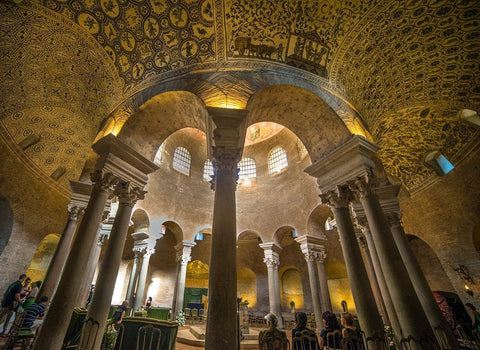Late Antique Roman Mosaics
Late antique roman mosaics are primarily displayed in Christian buildings such as churches today. Among these many churches, the Santa Costanza, Santa Pudenziana, and Santa Maria Maggiore, are some of the most prominent basilicas that encompass historically significant mosaics.
Santa Costanza

Santa Constanza interior - image from arte.laguia2000.com
The Mausoleum of Santa Costanza is one of the oldest churches in Rome. It was built in the 4th century for Costanza, one of the daughters of Emperor Constantine. Mosaics in the church decorate both its walls and ceilings, and represent some of the most important early Christian art in the 4th century. The ancient mosaics are historically significant because they illustrate the shift from pagan to Christian art, depicting early Christian dependence on pagan traditions. For example, the mosaics include scenes of grape harvesting, peacocks, amphorae, and vines that originated in pagan art. However, the symbolism of the mosaics are also incredibly accurate to the ruling style of Constantine, whose policies were to adapt pagan traditions to the rising Christian ideas.
Santa Pudenziana

Basilica of Santa Pudenziana - Image from SpottingHistory.com
Santa Pudenziana originally belonged to Senator Pudens, who gifted the house to Pope Pius I in 154AD after being converted to the Christian faith by Apostles Peter and Paul, who were guests in the house at one point. The mosaic of the church depicts Jesus in the center, surrounded by the twelve apostles. Made between 410 and 417 under Pope Innocent I, the mosaic was built to celebrate the Kingship of Christ, as inscribed in the book held by Christ in the artwork: “Dominus Servator Ecclesiae Pudentianae” or “The Lord who Saved the Church of Pudens.” The mosaic was saved during restoration of the church, but the rebuilding of the altar zone cut away the last two apostles of the Mosaic, leaving only ten.
Santa Maria Maggiore

Santa Maria Maggiore - image from www.alanzeleznikar.com
The church of Santa Maria Maggiore boasts mosaics all across its exterior facade, which illustrate the origin of the basilica. The Blessed Virgin appears in the dreams of Pope Liberius and the Roman Patrician John, inspiring the location of the church. Following, in August 358, snow covered the Esquiline Hill, wherein the Pope traced the perimeter of the church where it is today. Fifth century mosaics, commissioned by Pope Sixtus III also run along the nave and triumphal arch of the church. The mosaics account for the four cycles of Sacred History featured Abraham, Jacob, Joshua, and Moses. Together, they testify to God’s promise of and assistance towards a land for the Jewish people.
Works Consulted
“The Mausoleum of Santa Costanza: Ancient Mosaics and a Round Church,” Revealed Rome,
Revealed Rome, 29 September 2011.
“The Basilica: The Mosaic of St. Pudenziana,” St. Pudienza, Basilica di Santa Pudenziana in
Roma, n.d.
“Inside the Basilica,” Vatican.va, The Papal Basilica Santa Maria Maggiore, n.d.
Our sustainability practices have always been part of Mozaico’s principles - and it’s something we’re proud of. Rest assured that you’re purchasing the highest-quality mosaic art from a company that cares.
